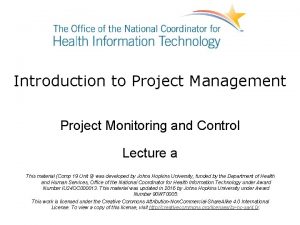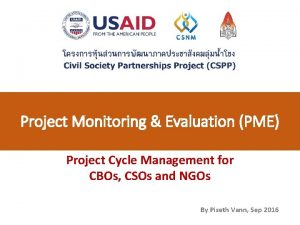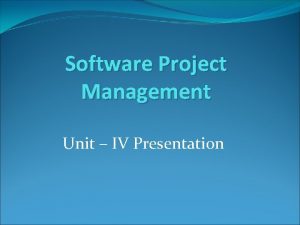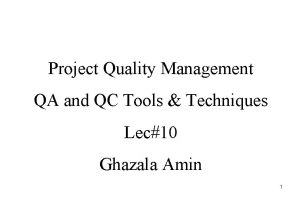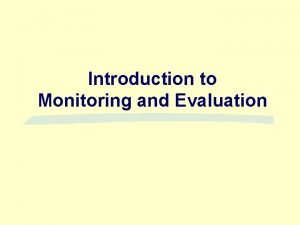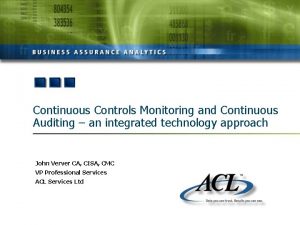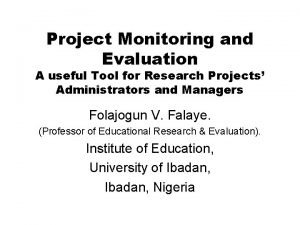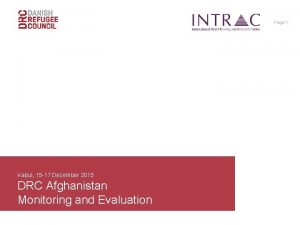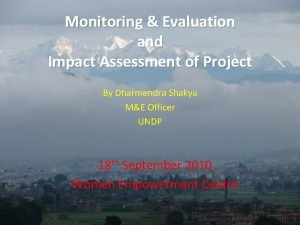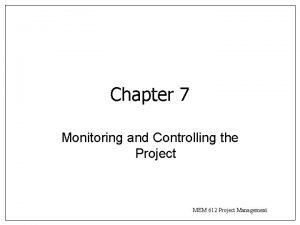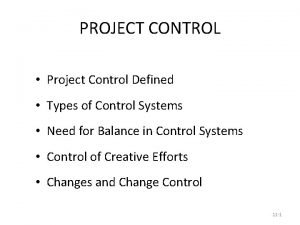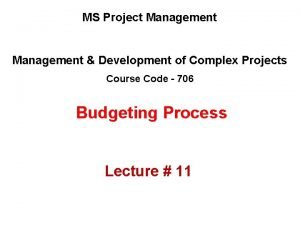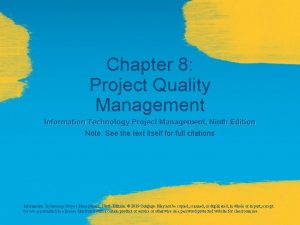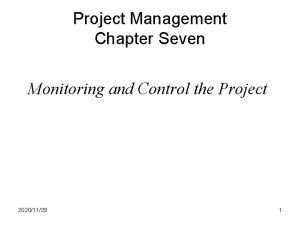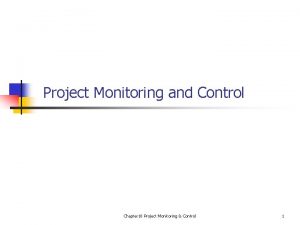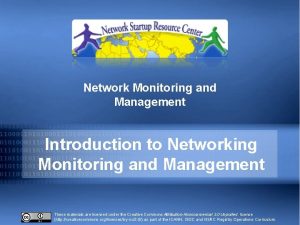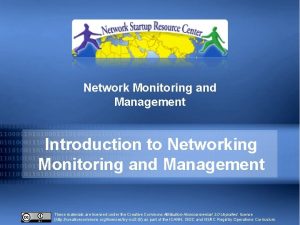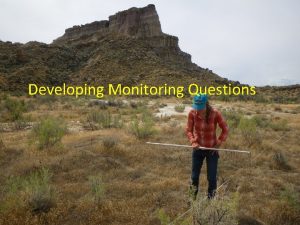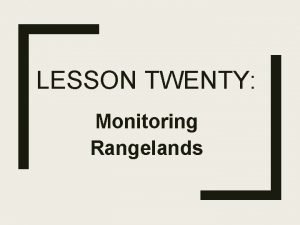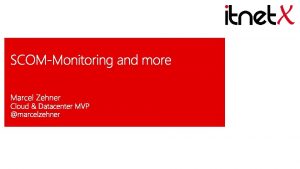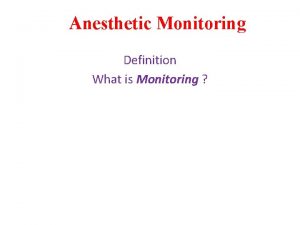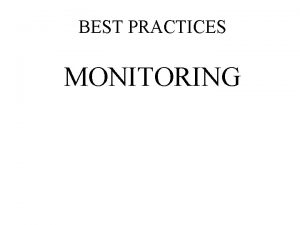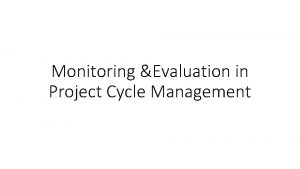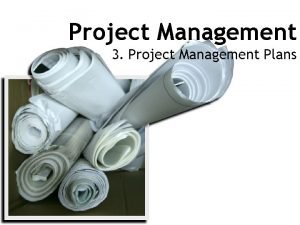Introduction to Project Management Project Monitoring and Control

















- Slides: 17

Introduction to Project Management Project Monitoring and Control Lecture b This material (Comp 19 Unit 9) was developed by Johns Hopkins University, funded by the Department of Health and Human Services, Office of the National Coordinator for Health Information Technology under Award Number IU 24 OC 000013. This material was updated in 2016 by Johns Hopkins University under Award Number 90 WT 0005. This work is licensed under the Creative Commons Attribution-Non. Commercial-Share. Alike 4. 0 International License. To view a copy of this license, visit http: //creativecommons. org/licenses/by-nc-sa/4. 0/.

Project Monitoring and Control: Learning Objectives — Lecture b • Direct project execution. • Track, review, and report project progress and performance. • Monitor and control project baselines. • Manage stakeholder expectations and change requests. 2

Monitor and Control Project Schedule • Purpose of the control schedule process. – Monitor the schedule baseline. – Report progress of the schedule. – Ensure project activities are in alignment with the schedule baseline. – Manage changes to the schedule baseline. • How to monitor and control the schedule. – Document the work accomplished. – Compare actual progress with the project schedule. – Process change requests. – Use schedule compression techniques. 3

Keeping a Project on Schedule • Check milestones. – Points in time when tasks are scheduled to be completed – are they completed on time? • Assess deliverables. – Are they completed on time? – Is the quality acceptable? • Check on team work practices. – Working extra hours? – Is schedule too relaxed? – Talk to your team—how is morale? 4

Getting a Schedule Back on Track • Duration compression techniques. • Crashing: adds resources. – Probable increased project costs. – May cause further delays. • Fast tracking: overlaps activities normally performed in sequence. – Probable increased project risk and rework. – Rework may cause further delays. 5

Monitor and Control Quality • Purpose of the perform quality process. – Monitor and record results of executing the quality activities to assess performance. – Recommend and take corrective actions when appropriate. • How to control quality – Use the quality management plan to control quality. – Verify deliverables align to the quality standards required. – Identify causes of poor project processes or product quality. – Recommend preventive and corrective actions. – Process change requests by taking corrective action when required. 6

Project Reporting • Deliverables. – Progress. – Project status or health. – Upcoming activities. • Risks and critical issues. • Financial status and forecasts. • Action plans or next steps. 7

Administer Procurements • Monitor and exercise control over all procurements so they result in on-time delivery of products and service. • Supporting documents: – Procurement management plan—part of project management plan. – Contract awards. – Statements of work. • Supporting personnel—from the contracting office. • Review performance on all procurements: – Work meets contract specifications, statement of work. – Delivered on time. – Performance reports from suppliers. • Evaluate any change requests. 8

Monitor and Control Risk • Purpose of the monitor and control risks process. – Implement risk response plans, track identified risks, identify new risks, and evaluate the effectiveness of the risk response actions. • How to monitor and control risks. – Conduct periodic staff meetings to evaluate actual work performance results with planned results in the project management plan. • Consider keeping a “top ten risk. ” • Updating project documents. – Project documents must be updated to reflect the outcomes of implementing risk responses, outcomes of risk reassessments and audits, and change requests for preventive and corrective actions. 9

When Problems Arise … • Bad things can happen to good projects—abrupt departure of key people, natural disasters, late shipment of needed supplies, technology failures. • When problems arise, think before you act: – Investigate the problem to identify the underlying cause and possible workaround alternatives. – If indicated, conduct a special meeting focused on addressing the problem. – Determine the impact of the problem on the schedule, cost, deliverables. o Can built-in slack absorb effect on schedule? o Can staff resources be re-allocated? – Assess need to escalate problem to senior management and other stakeholders. 10

Monitor Project Issues • Keep an issues log. – Identify issues that arise in meetings with stakeholders, service providers, senior managers, customers, and at project status meetings. – Number each issue with ID number, date, description, planned response, status, and responsible party for resolving it. • Use word processing or spreadsheet software to help you maintain the log! 11

Managing Changes • Changes will occur in your project: – Plan for them—e. g. , by your choice of a life cycle model that is adaptive or by having budget reserves (where feasible). – Even if you do plan for change, there will be unexpected changes. • Changes arise from any stakeholder, for example: – Team member wants to add a new feature to the system. – Customer wants faster system response time. – Vendor upgrades product, so cost is higher. – Lead designer leaves the company. 12

Processing Change Requests • Establish a formal change request process: – Document it in the project management plan. – Follow it! • Review changes for impact on project time, cost, deliverables, and stakeholders. • Decide to accept or reject proposed changes. • Make all necessary adjustments to documents, budgets, schedules, and deliverables. • Communicate the adjustments to all stakeholders. 13

Techniques for Handling Change Requests • Use a Project Steering Team or Change Control Board (CCB) with members approved by stakeholders. • Use configuration management procedures and tools to control the design and characteristics of products and their documentation. • Document all change requests—even oral, informal, and minor ones. 14

Project Monitoring and Control Summary — Lecture b • Monitoring and controlling involves a set of diverse activities. • As a PM, you must exercise control over project cost, schedule, scope, quality, risk, changes, and communications. • Your effectiveness in monitoring and controlling will help to ensure project success. 15

Project Monitoring and Control References — Lecture b References • Bennatan, E. M. On Time Within Budget: Software Project Management Practices and Techniques, 3 rd Edition. New York: John Wiley & Sons; 2000. • Fleming, Q. W. , and Koppelman, J. M. Earned Value Project Management, 3 rd Edition, Newtown Square, PA: PMI; 2006 • Health Information and Management System Society. Chicago, IL. 2010. Available from: www. himss. org • Houston S, Bove LA. Project management for healthcare informatics. Springer Science + Business Media, LLC; 2010. • Kerzner H. Project management: a systems approach to planning, scheduling, and controlling. 10 th ed. Wiley; 2009 • Nicholas, J. M. , and Steyn, H. Project Management for Business, Engineering, and Technology, 4 th Edition, Oxford, UK: Butterworth-Heinemann, 2011. • A Guide to the Project Management Body of Knowledge: (pmbok Guide). 5 th ed. Newtown Square, Pa. : Project Management Institute, 2013 • Project Management Institute, Practice Standard for Earned Value Management. 2 nd ed. Newtown Square, PA: PMI; 2011. • Schwalbe K. Information technology project management. 8 th ed. ; Cambridge, MA: Course Technology; 2015. • Venkataraman, R. R. , and Pinto, J. K. Cost and Value Management. New York: John Wiley & Sons; 2011. 16

Introduction to Project Management Project Monitoring and Control Lecture b This material (Comp 19 Unit 9) was developed by Johns Hopkins University, funded by the Department of Health and Human Services, Office of the National Coordinator for Health Information Technology under Award Number IU 24 OC 000013. This material was updated in 2016 by Johns Hopkins University under Award Number 90 WT 0005. 17
 Project management monitoring and controlling
Project management monitoring and controlling M&e cycle
M&e cycle Ball chart in spm
Ball chart in spm Importance of software project management
Importance of software project management Qa tools and techniques
Qa tools and techniques Introduction to monitoring and evaluation
Introduction to monitoring and evaluation Continuous control monitoring
Continuous control monitoring Continuous auditing continuous monitoring
Continuous auditing continuous monitoring Control loop performance monitoring
Control loop performance monitoring Differentiate monitoring and evaluation
Differentiate monitoring and evaluation Example of monitoring and evaluation in project proposal
Example of monitoring and evaluation in project proposal What are the objectives of evaluation
What are the objectives of evaluation Plan monitor control cycle
Plan monitor control cycle Cybernetic control project management
Cybernetic control project management Control accounts project management
Control accounts project management Project management quality control
Project management quality control Project management quality control
Project management quality control Go no go control project management
Go no go control project management
